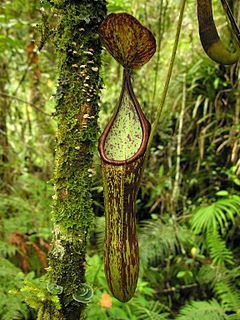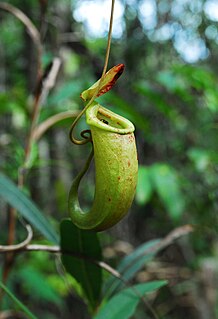
Nepenthes sibuyanensis is a tropical pitcher plant endemic to Sibuyan Island in the Philippines, after which it is named.

Nepenthes copelandii is a species of pitcher plant native to the island of Mindanao in the Philippines. Originally known from Mount Apo near Davao City and Mount Pasian near Bislig, it has since been discovered on a number of peaks throughout Mindanao. It may also be present on the nearby island of Camiguin. The species has a wide altitudinal distribution of 1100–2400 m above sea level. Nepenthes copelandii has no known natural hybrids. No forms or varieties have been described.

Nepenthes mindanaoensis is a tropical pitcher plant native to the Philippine islands of Mindanao and Dinagat.

Nepenthes bellii is a tropical pitcher plant endemic to the Philippine islands of Mindanao and Dinagat, where it grows at elevations of 0–800 m above sea level.

Nepenthes mantalingajanensis is a tropical pitcher plant known only from the summit region of Mount Mantalingajan, the highest point on the Philippine island of Palawan, after which it is named.

Nepenthes peltata is a tropical pitcher plant known only from the upper slopes of Mount Hamiguitan on the island of Mindanao in the Philippines. It is characterised by a peltate tendril attachment and conspicuous indumentum. The species typically produces ovoid pitchers with a prominent basal crest and large nectar glands on the lower surface of the lid.

Mount Hamiguitan is a mountain located in the province of Davao Oriental, Philippines. It has a height of 1,620 metres (5,315 ft). The mountain and its vicinity has one of the most diverse wildlife populations in the country. Among the wildlife found in the area are Philippine eagles and several species of Nepenthes. Some of the latter, such as the Nepenthes peltata and Nepenthes micramphora, are endemic to the area. The mountain has a protected forest area of approximately 2,000 hectares. This woodland is noted for its unique pygmy forest of century-old trees in ultramafic soil, with many endangered, endemic and rare species of flora and fauna.

Nepenthes micramphora is a tropical pitcher plant known only from Mount Hamiguitan on the island of Mindanao in the Philippines. It is a highland plant growing at elevations of 1100–1635 m.

Nepenthes hamiguitanensis is a tropical pitcher plant endemic to a single peak on the Philippine island of Mindanao, where it grows at elevations of 1200–1600 m above sea level. Once thought to be a natural hybrid between N. micramphora and N. peltata, this plant is now considered a species of possible hybridogenic origin. It produces squat upper pitchers that vary greatly in pigmentation, from red speckled to yellow throughout.

Nepenthes leonardoi is a tropical pitcher plant known from a single locality in central Palawan, the Philippines. It is closely allied to several other Palawan endemics, including N. deaniana, N. gantungensis, and N. mira. The traps of this species reach at least 24 cm in height. Some specimens are noted for producing very dark, almost black, upper pitchers.

Nepenthes ramos is a tropical pitcher plant native to the northeastern Mindanao, Philippines. It is known from only a handful of herbarium specimens collected in 1919 at an elevation of 670 m above sea level. It likely grows in the forest on ultramafic soils.

Nepenthes viridis is a tropical pitcher plant endemic to the Philippines. It is known only from coastal areas at low altitude and has been recorded from Dinagat, Samar, and a number of surrounding islets. It is closely allied to the N. alata group of species.

Nepenthes abgracilis is a tropical pitcher plant native to the Philippines. It is known only from northeastern Mindanao, including Mount Legaspi. Little is known about the altitudinal distribution of this species, but the holotype was collected at 670 m.

Nepenthes justinae is a tropical pitcher plant known only from Mount Hamiguitan on the Philippine island of Mindanao, where it grows at elevations of 1000–1620 m above sea level.
Nepenthes malimumuensis is a tropical pitcher plant endemic to Pantaron Range on the island of Mindanao in the Philippines, where it grows at elevations of 1000–1020 m above sea level.
Nepenthes manobo is a tropical pitcher plant endemic in the Philippines discovered in the Pantaron Range on the island of Mindanao, where it grows at a narrow elevation range of 1000–1020 m above sea level.
Nepenthes alfredoi is a tropical pitcher plant endemic to the Philippines on the Mt. Hamiguitan Range on the island of Mindanao in the Philippines, where it grows at elevations of 160–345 m above sea level.
Nepenthes cabanae is a tropical pitcher plant endemic to Mt. Malimumu, Pantaron Range, Central Mindanao, Philippines, bringing the total number of Nepenthes species in this mountain range to eight. Nepenthes cabanae was assessed as closest to N. surigaoensis. However, N. cabanae has sessile leaf attachment clasping up to half of the stem running down the internode unevenly, with four longitudinal nerves running parallel with the midvein, subcylindrical lower and intermediate pitchers, and short triangular peristome margin teeth approximately 0.3-0.5 mm in length but not projecting beyond margin; compared with N. surigaoensis with strongly decurrent leaf attachment, 3-4 longitudinal nerves in parallel with midvein, wholly cylindrical or ellipsoidal lower and intermediate pitchers, and distinct peristome margin teeth projecting beyond the margin.













